John Flanagan first created the Washington Quarter Dollar in 1932, and it has since become one of the longest-running US coin series. Up to 1964, Washington quarters were made with 90% silver.
Circulating Washington quarters were first struck in a copper-nickel alloy starting in 1965, and from that year through 1968, no mint-marked coins were produced.
To commemorate the country’s bicentennial, quarters were struck in 1975 and 1976 with a special 1776–1976 dual date feature on the obverse and a Colonial drummer kid design on the reverse.
Find out more about the 1939 Washington quarter below!
What Is the 1939 Washington Quarter Made Of?
The 1932 Washington quarter dollar was initially intended as a commemorative coin to mark George Washington’s 200th birth anniversary. It would have been the second commemorative quarter dollar (the first was the Isabella Quarter Dollar of 1893). The currency was so well received that it was kept as a standard issue for circulation starting in 1934.
The coin was designed by John Flanagan, who was a sculptor widely known for his statuary and plaquettes but was more recognized for his coin designs and commemorative medals. It has a reeded edge and a metal composition of 90% Silver and 10% Copper. Its face value is set at $0.25 or a quarter dollar. The coin weighs 6.30 grams and has a diameter of 24.30 millimeters.
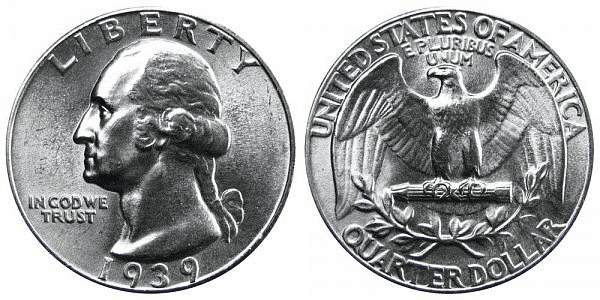
The left-facing portrait of Washington by Houdin, conceived by John Flanagan, appears on the coin’s obverse with the slogan IN GOD WE TRUST placed left to his neck. The word LIBERTY sits above the coin’s rim, and the year of minting at the bottom.
The words UNITED STATES OF AMERICA are written at the upper edge of the reverse, which depicts a bald eagle clutching arrows with its wings fully spread. The bottom of the design bears the denomination QUARTER DOLLAR. Between the eagle and the denomination are olive branches meeting in the middle. You can see the mint mark below the olive branch.
1939 Washington Quarter Varieties
Washington quarter dollars were struck for circulation in Philadelphia, Denver, and San Francisco. Only at the Philadelphia Mint were proof versions produced.
These are the varieties of Washington quarter dollars produced in 1939:
| Variety | Mint Location | Mintage |
| 1939 D Washington Quarter | Denver | 7,092,000 |
| 1939 S Washington Quarter | San Francisco | 2,628,000 |
| 1939 P Washington Quarter | Philadelphia | 33,540,000 |
| 1939 Proof Washington Quarter | Philadelphia | 8,795 |
| Total | 43,205,795 |
1939 D Washington Quarter
Year of minting: 1939
Mint Mark: D
Place of minting: Denver
Quantity produced: 7,092,000
Face Value: $0.25 (quarter dollar)
Price: $6.18 to $24.00 (circulated condition)
Mass: 6.30 grams
Edge: Reeded
Designer: John Flanagan
Composition: 90% silver and 10% copper
Diameter: 24.30 millimeters
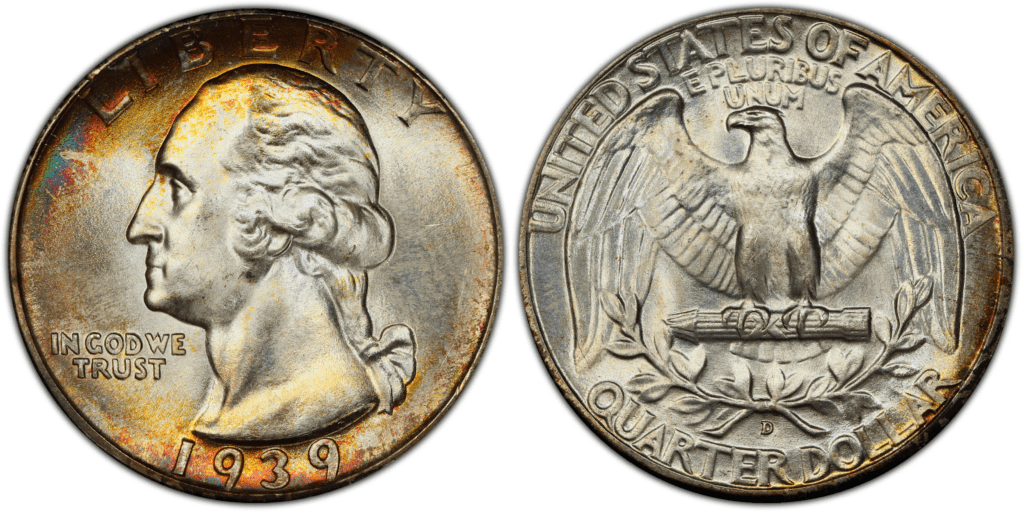
The 1939 D Washington quarters were expertly crafted and reflected the precise striking typical of Denver Mint coins in the late 1930s and early 1940s.
It may be said that the 1939 D Washington quarter is an undervalued date. The 1939 D has typically sold for less money, even though it is about as uncommon as many earlier mint-marked issues. There are frosty white Gems and toned specimens with various levels of hue.
Head to the NGC website and see that they estimated a 1939 Washington quarter worth between $8 and $42.50 (as of January 2023). However, 1939 D Washington quarters in pristine and uncirculated condition can be purchased for up to $1450 on the open market.
1939 S Washington Quarter
Year of minting: 1939
Mint Mark: S
Place of minting: San Francisco
Quantity produced: 2,628,000
Face Value: $0.25 (quarter dollar)
Price: $6.18 to $68.00 (circulated condition)
Mass: 6.30 grams
Edge: Reeded
Designer: John Flanagan
Composition: 90% silver and 10% copper
Diameter: 24.30 millimeters
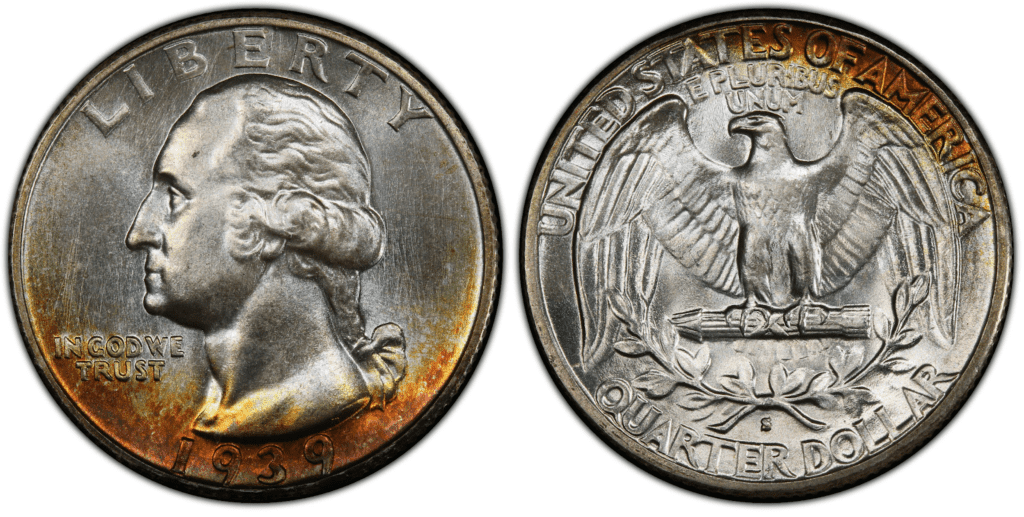
In the middle of the 1930s, several issues with extremely low mintages minted between 1930 and 1933 that had already attracted premiums gave rise to the trend of collecting American coins by date and mint.
Speculators frequently saved fresh rolls of new coins for decades thereafter in the hopes that lightning might strike twice. This has ensured that coins with a relatively low mintage, like the 1939-S quarter, will always be available in Mint State. Through MS 66, gems have received bulk certification.
Like the other S-mints from 1935 through 1939, the 1939 S Washington quarter has long been regarded as one of the Washington quarter series’ semi-key dates. Strike is rarely an issue, as Frosty Gems are often obtainable. This issue is available in very Gemmy condition.
A 1939 Washington quarter is worth between $8 and $85 when in circulated condition. This is according to the NGC Price Guide (January 2023). However, if you have one in pristine and uncirculated condition, you could sell it for as high as $10,000 on the open market.
1939 P Washington Quarter
Year of minting: 1939
Mint Mark: no mint mark
Place of minting: Philadelphia
Quantity produced: 33,540,000
Face Value: $0.25 (quarter dollar)
Price: $6.18 to $12.00 (circulated condition)
Mass: 6.30 grams
Edge: Reeded
Designer: John Flanagan
Composition: 90% silver and 10% copper
Diameter: 24.30 millimeters
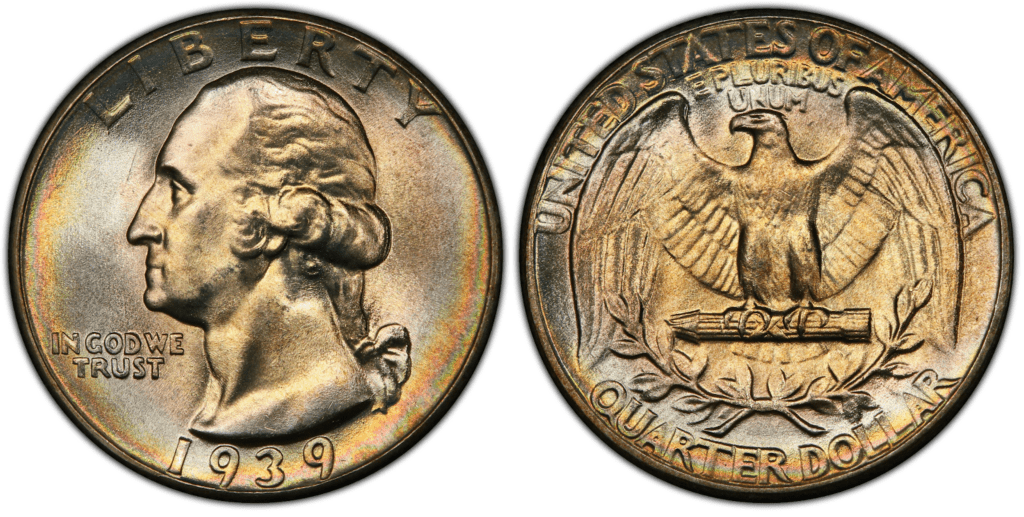
Although the American economy began to pick up steam by the end of 1938 and grew gradually over the ensuing several years, the Great Depression persisted until the country entered World War II in 1941. The Philadelphia Mint’s considerably increased quarter-dollar production for 1939 proves this development.
Large numbers of specimens in a mint state have been found in various die states, from hard, flat surfaces to deeply wrinkled ones. Even though the latter frequently has a brilliant shine, the discerning collector should look for an early die state with fine features.
The 1939 Washington quarter is the easiest to find in MS66 and MS67 conditions from the 1930s. There are numerous nearly flawless Gems. A lot of specimens feature a wonderful tiny golden iridescent tint. This issue is nicely packaged!
As of early this year, the NGC Price Guide estimates that a 1939 Washington quarter in circulation is worth between $8 and $19.50. If sold on the open market, this same variety in pristine, uncirculated condition could be valued up to $1875.
List Of 1939 Washington Quarter Errors
Die Crack Error
A die crack happens when a die fractures under the intense pressure applied during the minting process, leaving a tiny breach in the die. The metal will fill in the crack if the broken die is used to manufacture coins again, leaving an elevated metal line in the completed coin.
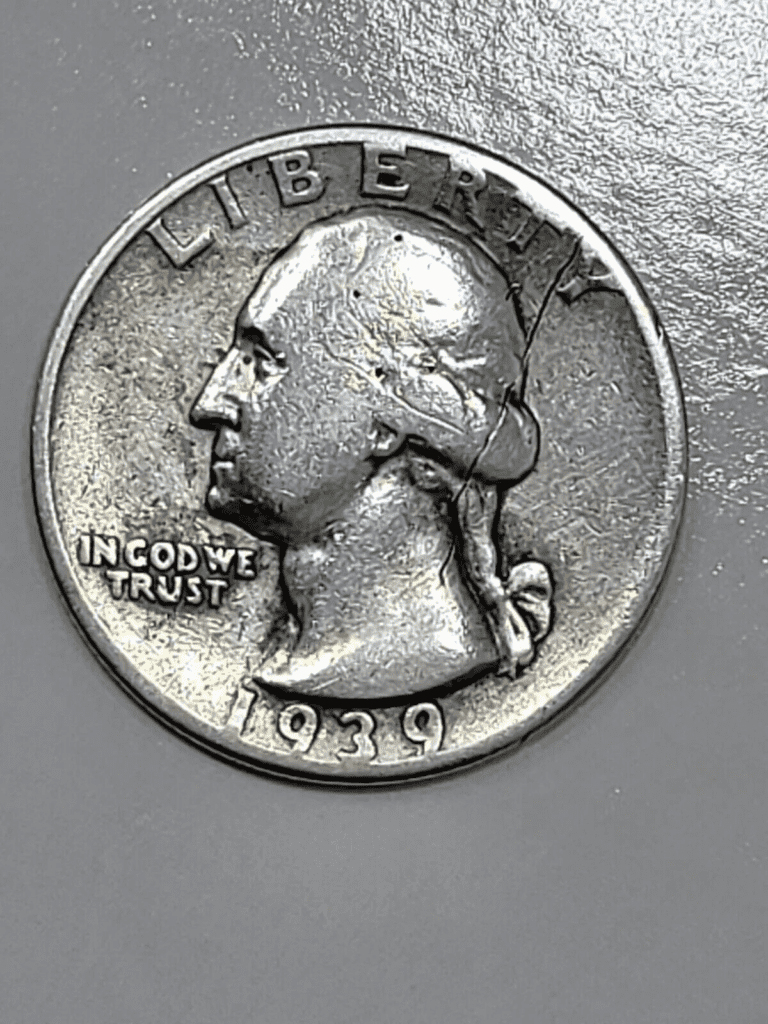
Doubled Die Error
Doubled die errors occur when duplication of design elements on a working die is caused by a misalignment of the hub or die during the hubbing process.
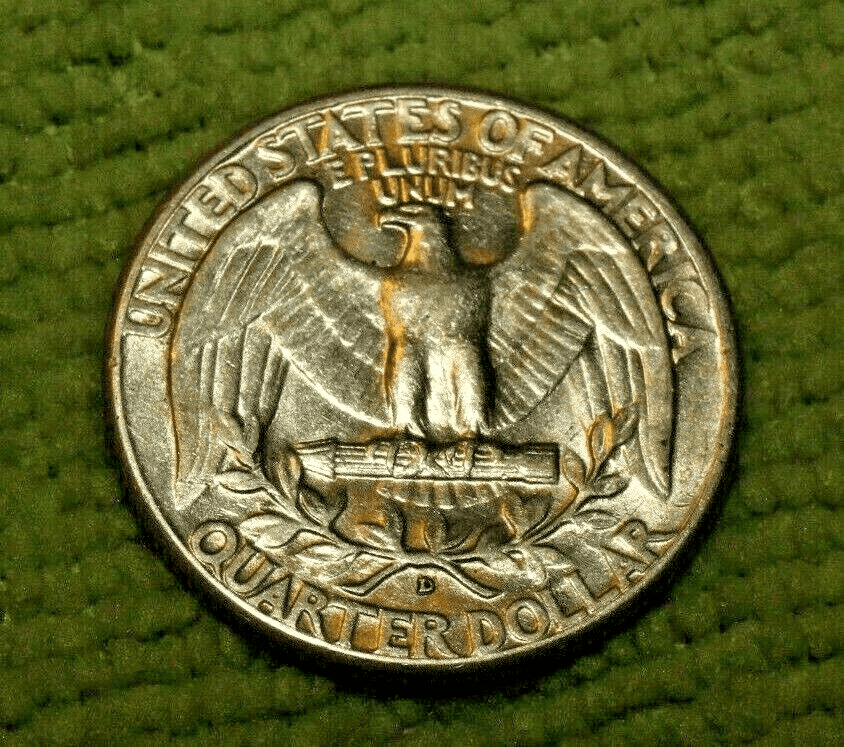
How Much Is The 1939 Washington Quarter Worth Today?
Washington quarters have a face value of $0.25 or quarter dollars and a melt value of $4.34.
According to the USA Coin Book, the 1939 D Washington quarter has an estimated value of $6.18 in average condition and can be worth up to $133 or more in uncirculated (MS+) mint condition.
The 1939 S Washington quarter is valued at $6.18 in Average Condition and can be worth up to $354 or more in Uncirculated (MS+) Mint Condition.
Finally, the 1939 Washington quarter has an estimated value of $6.18 in average condition and can be worth up to $68 or more in uncirculated (MS+) mint condition. Proof coins have a value of up to $287.
Below is a comparison table showing the auction records for each 1939 Washington quarter dollar coin. This should then give you an idea of how much they are potentially worth:
| Coin | Condition | Grade | Sold date | Sold by | Value |
| 1939 D Washington Quarter Dollar | Superb Gem Uncirculated | MS 68 | August 31, 2022 | Stack’s Bowers | $14,400 |
| 1939 Proof Washington Quarter Dollar | Gem Uncirculated | PR 65 | December 8, 2022 | Legend Rare Coin Auctions | $12,925 |
| 1939 S Washington Quarter Dollar | Superb Gem Uncirculated | MS 67+ | April 27, 2016 | Heritage Auctions | $9,988 |
| 1939 S Washington Quarter Dollar | Superb Gem Uncirculated | MS 68 | April 18, 2012 | Heritage Auctions | $8,625
|
How Coins are Graded
The Sheldon Scale is used by numismatists to provide a numerical value to coins. The Sheldon Scale goes from poor (P-1) to perfect mint state (P-1) (MS-70). Coins were originally evaluated using words to reflect their condition (Good, Fair, Excellent, Etc.). Unfortunately, coin collectors and dealers had different ideas about what each of these terms represent.
Professional numismatists joined together in the 1970s and established CoinGrading standards. These numismatists now assign grades at key places on the seventy-point scale, using the most regularly utilized numeric points in conjunction with the original adjective grade. The following are the most common coin grades:
- (P-1) Poor – Indistinguishable and probably damaged; if used, must have a date and mintmark; otherwise, rather battered.
- (FR-2) Fair – Nearly smooth, but without the damage that a coin graded Poor often possesses. The coin must have enough detail to be identified.
- (G-4) Fair – Inscriptions have merged into the rims in some areas, and important elements have been mostly erased.
- (VG-8) Very Good- A little weathered, but all of the primary design elements are visible, albeit faintly. There is little if any, central detail left.
- (F-12) Good – The item is very worn, yet the wear is even, and the overall design details stand out clearly. Rims are almost completely isolated from the field.
- (VF-20) Very Fine – Moderately weathered, with some finer features still visible. The motto or all letters of LIBERTY are readable. Both sides of the coin have entire rims that are separated from the field.
- (EF-40) Extremely Fine – Gently used; all gadgets are visible, and the most important ones are bold. The finer details are bold and clear, however, light wear may be seen.
- (AU-50) Uncirculated – Slight evidence of wear on the coin’s design’s high points; may have contact marks; eye appeal should be adequate.
- (AU-58) Uncirculated Choice – Slight traces of wear, no severe contact marks, almost full mint shine, and great eye appeal.
- (MS-60) Mint State Basal – Strictly uncirculated; no indication of wear on the coin’s highest points, but an unsightly coin with reduced luster, visible contact marks, hairlines, and other flaws.
- (MS-63) Mint State Acceptable – Uncirculated, but with contact scratches and nicks, little reduced shine, but otherwise appealing appearance. The strike is weak to average.
- (MS-65) Mint State Choice – Uncirculated with great mint shine, very little contact blemishes, and exceptional eye appeal. The strike is unusually severe.
- (MS-68) Mint State Premium Quality – Uncirculated with superb luster, no obvious contact marks to the naked eye, and exceptional eye appeal. The strike is quick and appealing.
- (MS-69) Almost Perfect Mint State – Uncirculated with perfect brilliance, a sharp and appealing strike, and extremely good eye appeal. A near-perfect coin with minor imperfections in the planchet, strike, and contact markings (seen only under 8x magnification).
- (MS-70) Mint State Perfect – Under 8x magnification, there are no tiny imperfections discernible; the strike is crisp, and the coin is perfectly centered on a beautiful planchet. Rarely seen on a coin, this coin is bright and whole, with original luster and exceptional eye appeal.
Where To Buy Or Sell 1939 Washington Quarter?
The most convenient way to buy or sell 1939 Washington quarter dollars is through online auctions and online markets. On websites like eBay, Etsy, Craigslist, and Amazon, among others, most sellers post bids. However, coin and antique shops are other places to buy or sell your coins. Finding a particular coin there may be more difficult.
Professional coin appraisers from the PCGS and the NGC can also assist if you need advice on where and how to buy or sell your 1939 Washington quarter dollars.
FAQs
Is a 1939 quarter pure silver?
No. The 1939 Washington quarter has a metal composition of 90% Silver and 10% Copper.
How much does a 1939 quarter weigh?
A 1939 Washington quarter dollar weighs 6.30 grams.
How much is a 1939 Washington quarter with no mint mark worth?
1939 Washington quarter dollars produced at the Philadelphia Mint do not bear any mint mark. This variant is estimated at $6.18 in average condition and can be worth up to $68 or more in uncirculated (MS+) mint condition. Proof coins have a value of up to $287.
Where is the mint mark on a 1939 quarter?
You can see the mint mark below the olive branches in the middle of the coin’s design, just below the bald eagle, and above the coin’s denomination.
